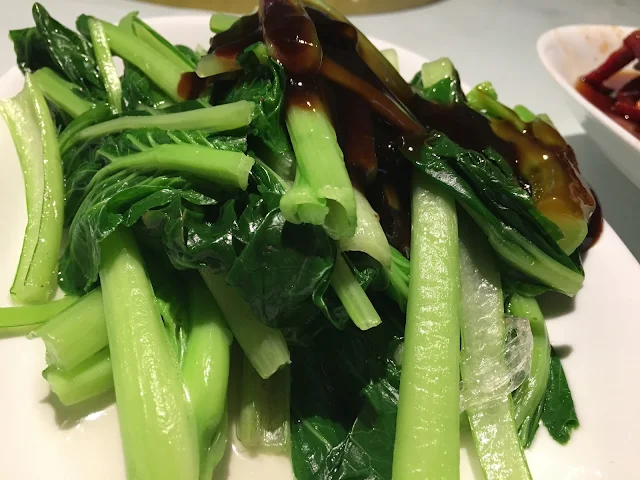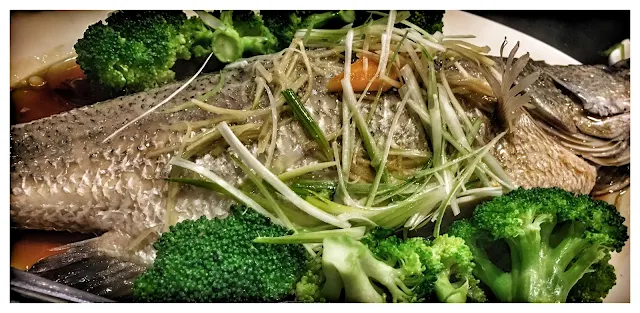The competition for southern Chinese barbequed meat shops can be intense. Almost every self-respecting suburb with sizeable Asian populations in the metropolitan areas of Sydney, Brisbane and Melbourne these days boast of such a butcher and BBQ outlet.
The meats - duck, pork or chicken - provide for an easy take away especially for busy families. It is not just in the marinades utilised, but also in the cut of the meats, the critical drying of the skins and the presentation, that distinguishes quality from the ordinary.
 |
| Char Siew Yoke -- lean cuts of pork with the well known sauce. |
After 33 years sited at Goulburn Street, BBQ King began a new chapter moving to Liverpool Street in mid 2016. Owner Philip Chau has transformed the self-owned restaurant from retro comfort to a spanking three level facility that is more in tune with contemporary customers, of which he can seat around 200 in one go. If you get a table at a higher level, you can even view the goings-on below. Kitchens are more transparent, even if the de rigour practice of hanging those marinated roasted meaty birds continue.
Despite a good move to an upgrade of premises, the food menu still has your ever green favourites. Reliable are their version of fried rice, suckling pig, steamed chicken, marinated boneless trotter and if you dare, chicken feet bathed in vinegar and soy sauce.
Little touches of brewed pork bone soup offered at the start of communal tables, the freshness and bite of greens spewed with oyster sauce and the use of fresh ingredients help to continue BBQ King's reputation. Service is fast, requests are not turned down and hot soups predominate.
The old school, echoed by the veteran chefs in the kitchen, seem to blend with a renewed sense of staff engagement and interior vibes that appeal to to the younger generation. One has to be careful of the stairs, but they are short ones. The high ceilings that form the main portion of the revamped restaurant is a definitely good idea - it breaks down any feelings of being caved in, even if the audio levels can be so stereotyped Chinatown at times.
 |
| Yummy and compulsory must have roast pork cuts with crispy crackle and tender juicy meat. |
Are prices higher than most at this BBQ King? Look at what is asked for Beijing duck. BBQ King also holds yum cha sessions. Servings are reportedly smaller than what regular customers are used to from the old days at the old place at Goulburn Street. Is BBQ King transitioning to a new world and business model? The restaurant ambiance has improved and staff are attentive. What can we say.....
The bite and experience of roast pork here is inevitably compared to those at Tawandang Thai along lower George Street and that of the Laotian Green Peppercorn at the Civic Hotel.
 |
| Cantonese styled roast duck on a plate. |
The duck roasted Guangzhou style seem more oily, are more chunky in serve and yet provide more yumminess in the meat than in the skin. Five spice powder, both ground and fresh ginger plus vinegar are essential components utilised when preparing such Guangzhou ducks. BBQ King is an institution in the history of Chinese-Australians and their recipe is a treasure to behold.
A quick question from a child - why must Chinese food have such a reddish glaze for its meats? We know the colour red is culturally auspicious. Hmmn, even the staff at BBQ King here have a bright red coloured uniform. That colour does capture attention. Another explanation is the use of the seasonings and flavourings, like maltose, red fermented bean curd, honey and Sherry.
Next I aim to try the noodle dishes and the Beijing duck, served with wraps, Hoisin sauce and all....
 |
| Scallops, mushrooms, prawns, squid and Tofu slabs - life is good. |
The test of any self-respecting Chinese restaurant is in the uplifting flavours from a quick wok stirring of bite sized veg and seafood ingredients. Simplicity and good taste is the best outcome from such tests and I reckon BBQ King passes on such parameters.
The kids at my table wanted omelette, and so they did, filled with glad tidings. Our group of more than a dozen persons were given a huge table on the uppermost level, from which we could see the street below, with lights and all.
 |
| Bitter gourd slices are stir fried - one of my fav dishes! |
My impressions from my visit to BBQ King in Sydney Chinatown are:
Ambiance: 3 out of 5
Staff Engagement: 3.5 out of 5
Culinary Delight: 3.5 out of 5
X Factor: 3 out of 5
Overall Score: 13/4 out of 5
BBQ King Restaurant visited is located at 76-78Liverpool Street, Haymarket, Sydney NSW, near the junction with Sussex Street, across the junction from Hawker and a short walk from Darling Harbour's Darling Quarter.
Opening hours are from 10am to midnight every day.
Contact + 612 9267 2568






























